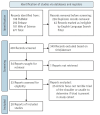Timing of surgery for terrible triad of the shoulder: a systematic review
- PMID: 40275807
- PMCID: PMC12151648
- DOI: 10.5397/cise.2024.00829
Timing of surgery for terrible triad of the shoulder: a systematic review
Abstract
The terrible triad of the shoulder (STT) is an injury involving anterior shoulder dislocation, rotator cuff tear, and nerve injury. The optimal timing for rotator cuff repair (RCR) remains controversial, with some favoring early intervention and others recommending delaying surgery until nerve recovery. A systematic review was conducted in accordance with Preferred Reporting Items for Systematic Reviews and Meta-Analyses (PRISMA) guidelines, exploring STT treatment and RCR timing using PubMed, Embase, and Web of Science. The inclusion criteria were studies published in English and involving human subjects. Exclusion criteria included non-English articles, review papers, cadaveric studies, and studies on unrelated conditions. Time to surgery and outcomes related to shoulder and nerve function, such as range of motion, muscle strength, and sensation were analyzed qualitatively. Of 671 articles identified, 28 met inclusion criteria. Most patients underwent surgical RCR and demonstrated excellent functional and neurologic outcomes, with many achieving 150°+ flexion, 110°+ abduction, 4+/5 strength, and resolution of nerve hypoesthesia. RCR timing ranged from 10 days to 6 months, with comparable outcomes regardless of timing. Prompt RCR in STT may be beneficial for maximizing shoulder outcomes, while coexisting nerve injuries should be managed conservatively with watchful waiting, as most recover spontaneously.
Keywords: Operative surgical procedures; Rotator cuff tear; Shoulder; Shoulder dislocation; Braxial plexus injury.
Conflict of interest statement
None.
Figures
References
Publication types
LinkOut - more resources
Full Text Sources
Miscellaneous



